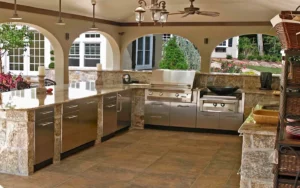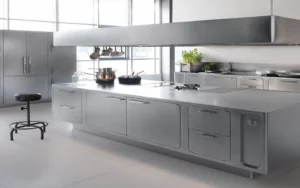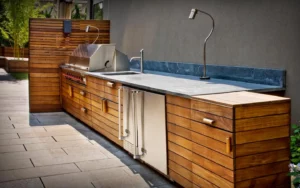Grilling and having food in your yard sounds like a great idea! Especially on a sunny day! But many of us might cancel it due to the lack of supplies in our yard, and the fact that we should carry all of them from the kitchen to our yard, which is a long and exhausting process, might stop us from doing it. So, where should we store our essential items without repeatedly going back and forth in the house? The simple answer is outdoor cabinets. Outdoor kitchen cabinets provide a secure, enclosed space for neatly organized cookware storage, barbecue fuel, and other items. In that case, you can have a great organized picnic in your yard.
You know what waterproof outdoor cabinets are, but you might ask, “why should I use them?” or “what are the differences?” Materials we choose for our outdoor kitchen cabinets should resist dirt, grill heat, seasonal climates, oil, and other elements. That’s why waterproof outdoor kitchen cabinets are food options. Like your indoor kitchen, your outdoor floors must be durable and easy to maintain. This area has a lot of foot traffic and is susceptible to food spills, grease, and general dirt and dust.
best material for outdoor kitchen frame
Choosing the best outdoor kitchen frame material depends on your budget, DIY skills, desired durability, and aesthetics. Wood is affordable and easy to work with, but needs maintenance. Concrete blocks are sturdy and fire-resistant, but require more skill. Metal studs with cement board offer mid-range cost and good durability, but demand more technical know-how. Stainless steel and marine-grade aluminum are high-end options for ultimate durability and low maintenance, while brick or stone veneer add classic style but require a strong foundation and regular cleaning. Ultimately, the right choice depends on your individual needs and priorities. Remember to check local building codes and consider your climate before making a decision.
What are Waterproof Outdoor Kitchen Cabinets Made of?
Protect the cabinets with sealant or even varnish. These can stand rain and storm and stay fresh more than other materials. Reapply as needed for easy maintenance. Here we are going to name some other materials along with their pros and cons for you to choose better:

HDPE Outdoor Cabinets (High-Density Polyethylene): The first material is HDPE. This high-density polyethylene (a strong, flexible, light, synthetic resin) is used in everything, including waterproof outdoor kitchen cabinets. HDPE is great for two things: Durable and easy to maintain. It is known for its excellent strength-to-density ratio, and that’s why it is ideal for outdoor kitchens.HDPE is also resistant to most chemicals and solvents so it won’t absorb oil or fat from your dishes. Maybe easily maintaining is the best advantage since these are waterproof outdoor kitchen cabinets. You have to wash it with a hose or a power washer simply. It’s very simple. Unfortunately, there are some disadvantages. The first one is that the material is sensitive to high heat, requiring an insulated grill jacket. The second one is that the colors can fade over time due to the effects of the sun.
Powder Coated Stainless Steel:These are stainless steel cabinets with dry powder fused to the surface for more protection. These powder-coated stainless steels for waterproof outdoor kitchen cabinets also have many beautiful colors, like blue and green. High-quality stainless steel is the perfect material for outdoor use. Resistant to corrosion and rust. Additionally, powder coating provides an additional layer of protection. Being metal, it is non-flammable and does not require an insulating jacket. The coating protects the stainless steel from the weather and facilitates the maintenance of this modern outdoor kitchen cabinet. Like other materials, it has its cons. The coating is hard to scratch, but if it is peeled off, the coating may come off.
In some cases, powder-coated cabinets are damaged, and peeling off piece by piece like eggshells have been seen. Moreover, it takes work to repair. Also, the peeled part may rust if made of stainless steel, which could be stronger. Despite being a durable material, it is often made very thin. Doing so may cause dents.

PVC Outdoor Kitchen Cabinets (Polyvinyl Chloride):PVC, or polyvinyl chloride, is another material that can be used. It’s a plastic-type material. In many ways, it’s similar to HDPE. Like HDPE, PVC does not rust or corrode and is easy to keep clean. Rinse off with a hose or power washer. But it is not as durable as HDPE. It may also change size in seasonal climates and different weather. PVC is often used as a decorative laminate over a lightweight resin foam backing. Although both are plastics, PVC is a weaker material than HDPE. A durable vinyl polymer. However, it is more susceptible to fading and warping in sunlight than HDPE. Like HDPE, grills also require an insulating jacket. Laminated PVC kitchen cabinets are also prone to delamination problems.
Explore Bay Area Kitchen Cabinets
Powder Coated Aluminum:The fourth option is powder-coated aluminum. Many popular brands offer powder-coated aluminum cabinets. Compared to stainless steel, they are much lighter. Luckily, powder coating works just like stainless steel. Protects surfaces from corrosion with a durable and beautiful layer. Cleaning this material is very easy as well. Unfortunately, just like powder-coated stainless steel, it is almost impossible to fix if your coating chips. The coating peels off, and the waterproof aluminum outdoor kitchen cabinets will corrode underneath.
Polished Stainless Steel:The next one is stainless steel! These waterproof outdoor kitchen cabinets are much shinier and smoother than powder-coated ones. Polished stainless steel provides a sophisticated look that complements built-in grills and outdoor appliances. Cons include that it can be used for any appliance except cabinets. When the sun hits it, it heats up and reflects off. Also, it will require more regular cleaning, polishing, and maintenance than the other options.
Wood:The last one on the list is wood, which is quite common between materials. Wood has a very nice and natural beauty. They come in all colors and can be cheaper than other options. Unfortunately, wood’s disadvantages outweigh its advantages; for instance, it might crack, deform, swell, and even rot. In addition, it fades in the sun and is susceptible to termite damage. Sealing is possible, but it takes time and effort and may require resealing every few years.
Learn more about wood kitchen cabinets

Outdoor Waterproof Cabinet with Shelves and doors
Outdoor waterproof cabinets with shelves are your year-round guardians for precious belongings. Whether you choose resin, metal, or wood, prioritize the right size, shelf count for organization (more shelves offer better compartmentalization!), and features like locks, wheels, or ventilation. Remember, balance price with quality and choose a style that complements your outdoor haven. With these tips, you’ll find the perfect cabinet, and adding shelves becomes your secret weapon for keeping everything neatly tucked away, rain or shine!
How do you waterproof outdoor cabinets?
Give Your Outdoor Cabinet a Weatherproof Shield!
Resin:
- Pre-sealed cabinets: Most good quality resin cabinets come pre-sealed with a weather-resistant coating. You might not need to do anything extra, but check the manufacturer’s recommendations.
- Unsealed cabinets: Use a high-quality acrylic sealant specifically designed for outdoor use. Follow the manufacturer’s instructions carefully, applying multiple thin coats for even coverage.
Metal:
- Galvanized steel or aluminum with anti-rust coatings: These already have good rust resistance, but you can apply a clear sealant for added protection.
- Regular steel: Choose a rust-oleum paint specifically designed for metal and apply multiple coats.
Wood:
- Pressure-treated wood: Already has some weather resistance, but apply a high-quality exterior stain or sealant for added protection. Reapply every 1-2 years.
- Untreated wood: Use a wood preservative followed by a high-quality exterior stain or sealant. Reapply regularly (every year or two) to maintain protection.
conclusion
Selecting the ideal material for an outdoor kitchen frame depends on several factors like budget, desired longevity, and visual appeal. Wood is cost-effective and user-friendly but demands upkeep. Concrete blocks are robust and resistant to fire but necessitate greater expertise. Metal studs with cement board are reasonably priced and long-lasting but require technical knowledge. Stainless steel and marine-grade aluminum are premium choices for maximum durability and minimal maintenance. Brick or stone veneer provide a timeless look but require a solid foundation and regular cleaning. Your decision should align with your specific needs and preferences.
KEYWORDS:
